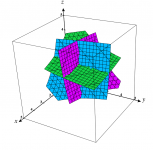I'm not going to show the numerical solution I had to the second problem, but perhaps I can provide some insights into it.
Let x be the resistance of the H1-H2 winding, y the resistance of the H2-H3 winding, and z the resistance of the H3-H1 winding.
Each of the three resistance measurements establishes its own associated equation in the variables x, y, z.
For each of the three equations I've plotted the surface containing the points x, y, z that are solutions to that particular equation.
The blue surface is defined by the RH1-H2 = 2.428mΩ measurement, purple surface by the RH2-H3 = 2.315mΩ measurement, green surface by the RH3-H1 = 2.445mΩ measurement.
The one point where all three surfaces intersect satisfies all three equations, and therefore it's the correct set of winding resistances x, y, z for the problem.
The following plot is on expanded scale where x, y, and z each range from 2 milliohms to 5 milliohms. This is just to show the curvature of the surfaces due the nonlinear equations, and to give some insight about what the equations represent. A numerical solution would need to be done to get an accurate result.
View attachment 2557517


